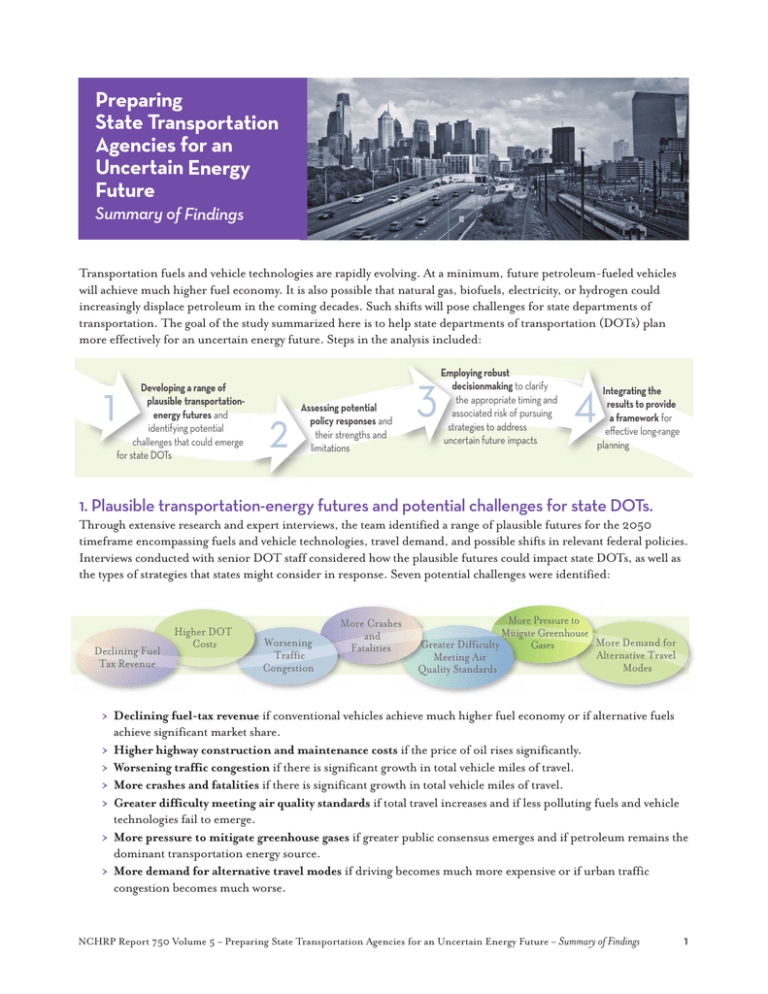Preparing State Transportation
advertisement

Preparing State Transportation Agencies for an Uncertain Energy Future Summary of Findings Transportation fuels and vehicle technologies are rapidly evolving. At a minimum, future petroleum-fueled vehicles will achieve much higher fuel economy. It is also possible that natural gas, biofuels, electricity, or hydrogen could increasingly displace petroleum in the coming decades. Such shifts will pose challenges for state departments of transportation. The goal of the study summarized here is to help state departments of transportation (DOTs) plan more effectively for an uncertain energy future. Steps in the analysis included: 1 Developing a range of plausible transportationenergy futures and identifying potential challenges that could emerge for state DOTs 2 Assessing potential policy responses and their strengths and limitations 3 Employing robust decisionmaking to clarify the appropriate timing and associated risk of pursuing strategies to address uncertain future impacts 4 Intteg Integrating the res results to provide a fframework for effective long-range effe plannii planning 1. Plausible transportation-energy futures and potential challenges for state DOTs. Through extensive research and expert interviews, the team identified a range of plausible futures for the 2050 timeframe encompassing fuels and vehicle technologies, travel demand, and possible shifts in relevant federal policies. Interviews conducted with senior DOT staff considered how the plausible futures could impact state DOTs, as well as the types of strategies that states might consider in response. Seven potential challenges were identified: Declining Fuel Tax Revenue Higher DOT Costs Worsening Traffic Congestion More Crashes and Fatalities More Pressure to Mitigate Greenhouse More Demand for Greater Difficulty Gases Alternative Travel Meeting Air Modes Quality Standards > Declining fuel-tax revenue if conventional vehicles achieve much higher fuel economy or if alternative fuels achieve significant market share. > Higher highway construction and maintenance costs if the price of oil rises significantly. > Worsening traffic congestion if there is significant growth in total vehicle miles of travel. > More crashes and fatalities if there is significant growth in total vehicle miles of travel. > Greater difficulty meeting air quality standards if total travel increases and if less polluting fuels and vehicle technologies fail to emerge. > More pressure to mitigate greenhouse gases if greater public consensus emerges and if petroleum remains the dominant transportation energy source. > More demand for alternative travel modes if driving becomes much more expensive or if urban traffic congestion becomes much worse. NCHRP Report 750 Volume 5 – Preparing State Transportation Agencies for an Uncertain Energy Future – Summary of Findings 1 2. Identifying and assessing potential strategies. After identifying potential impacts, the next step was to develop a set of candidate strategies—such as DOT efficiency measures, congestion pricing, or carbon taxes—that states could pursue to mitigate specific challenges or to promote a more desirable energy future. The team carefully assessed each strategy in terms of: Effectiveness in mitigating specific impacts or supporting certain energy goals Performance on broader economic, environmental, public health, and equity goals Barriers relating to cost, acceptance, technical risk, legislation, and institutional structure Lead time required to implement strategies and achieve desired results Based on their assessed strengths and limitations, and also considering the manner in which some strategies can complement one another, the research team rated, or prioritized, strategies for mitigating each of the potential challenges associated with plausible transportation-energy futures. For each mitigation objective, we rated strategies as most promising, optional (still beneficial, but posing less clear-cut tradeoffs between benefits and barriers), and fallback (least desirable in terms of common policy goals but generally preferable to taking no action at all). 3. Addressing uncertainty with robust decisionmaking. There are effective strategies for addressing all of the potential impacts that could arise with different plausible transportation-energy futures. The main challenge is uncertainty—some impacts occur in certain futures but not others. To address this uncertainty, we employed the principles of robust decisionmaking (RDM), a method for longterm policy analysis that enables the development of “robust” plans that should perform at least reasonably well however the future unfolds, with little chance of regret. One of the ways in which RDM supports robust plans is by preserving greater flexibility for future planners wherever possible. Specifically, RDM distinguishes between actions that merit near-term attention and actions that can be safely deferred until more information about how the future is unfolding becomes available. In parallel, RDM analysis helps to clarify the degree of risk associated with certain actions: Lower Risk Higher Risk Near-term robust strategies If a strategy appears useful, or at least benign, for all plausible futures, then it can be pursued in the near term with little chance of regret. Near-term hedging strategies Relying on signposts might not be feasible for strategies with very long lead times—land use reforms, for example, take decades to unfold. States can pursue such strategies in the near term as a hedge against certain futures, but this entails a greater degree of risk that the strategies will not end up being helpful or needed. Safely deferred strategies If a strategy is intended to mitigate a challenge that occurs in some futures but not others, and if there are signpost indicators (such as the price of oil, total vehicle miles of travel, or total crash fatalities) that can be monitored to provide advance warning of when the strategy will be needed, then the strategy can be safely deferred with little chance of regret. Near-term shaping strategies States might also pursue near-term strategies aimed at promoting (shaping) a more sustainable energy future. The main risk here is that the actions of a single state may do little to influence global energy and climate outcomes. NCHRP Report 750 Volume 5 – Preparing State Transportation Agencies for an Uncertain Energy Future – Summary of Findings 2 4. Integrated framework for robust long-term plans. The table below summarizes the results of the analysis, offering a comprehensive framework for robust long term plans that includes near-term robust strategies, safely deferred strategies, and potential hedging and shaping strategies entailing greater risk. For each objective, the table also lists strategies rated as most promising, optional with higher impact potential, and optional with lower impact potential (strategies listed in the table are defined at greater length in the main report). Objective Most Promising Strategies Optional High-Impact Strategies Optional Low-Impact Strategies Near-Term Strategies to Address Highly Probable Impacts Stabilize or increase DOT revenue / decrease DOT costs Fuel taxes Tolling or MBUF Registration fees Beneficiary fees DOT efficiency Land use Carbon pricing Congestion pricing Private capital Agency energy use Deferred Adaptive Strategies and Near-Term Hedging Strategies to Address Uncertain Impacts Mitigate traffic congestion Congestion pricing Goods movement TDM Public transportation Improve traffic safety Traffic safety ITS Goods movement TSM&O Improve air quality / reduce greenhouse gas emissions Improve non-automotive travel options ITS TSM&O Vehicle feebates Carbon pricing Goods movement TDM Land use Fuel mandates and programs Public transportation Fuel production and distribution Agency energy use Public transportation TDM Land use Traffic safety Congestion pricing ITS TSM&O Shaping Strategies to Influence Future Transportation-Energy Outcomes Promote more sustainable energy future Vehicle feebates Fuel taxes Land use Key ITS - intelligent transportation systems MBUF - mileage-based user fees TDM - transportation demand management Carbon pricing Fuel mandates and programs Public transportation Fuel production and distribution Agency energy use TSM&O - transportation system management and operations Green type denotes higher-risk hedging and shaping strategies. NCHRP Report 750 Volume 5 – Preparing State Transportation Agencies for an Uncertain Energy Future – Summary of Findings 3 Customizing strategic plans for state context. The analysis framework is intended to provide general guidance on effective long-range planning that should be applicable across states, but individual states can tailor plans in various ways to meet their own contextual needs. Options include selecting a preferred mix of strategies to address any given goal, omitting strategies that would not fit well within the context of a state, choosing whether or not to defer strategies to mitigate uncertain impacts (states with already sever traffic congestion, for example, may not wish to wait to see if it becomes even worse in the future), selecting signpost indicators that can be monitored in future years to determine whether and when to implement deferred strategies, choosing whether to pursue hedging or shaping strategies, and modifying the mix of policies included as part of a given strategy. Customization Options Selecting a preferred mix of strategies Omi!ing strategies that would not fit well within the context of a state Deferring or proceeding with strategies to mitigate uncertain impacts Selecting signpost indicators to monitor for deferred strategies def defe Choosing whethe whether to pursue p ue hedging or shaping strategies Modifying the mix of policies included as part of a given strategy While there are highly effective strategies for mitigating all of the potential impacts identified in this study, many fall beyond the existing authority of most state DOTs and thus are likely to require enabling state or even federal legislation. In developing their long-range plans, state DOTs may therefore wish to identify backup strategies that could be pursued, if helpful, without the need for legislation. This document summarizes material from NCHRP Report 750 Volume 5: Preparing State Transportation Agencies for an Uncertain Energy Future 2013 Report authors: Paul Sorensen, Tom Light, Constantine Samaras, Endy M. Daehner, Liisa Ecola, David S. Ortiz, and Martin Wachs, RAND Corporation Evan Enarson-Hering and Steven Pickrell, Cambridge Systematics, Inc. Graphic design by Sharp & Company ACKNOWLEDGEMENT This research report was performed under NCHRP Project 20-83(04) by RAND Corp. as the primary contractor, and Cambridge Systematics, Sharp & Company, and University of California Davis Institute of Transportation Studies as subcontractors. The research was sponsored by the American Association of State Highway and Transportation Officials, in cooperation with the Federal Highway Administration, and was conducted in the National Cooperative Highway Research Program, which is administered by the Transportation Research Board of the National Academies. The opinions and conclusions expressed or implied in reports are those of the research agencies. They are not necessarily those of the Transportation Research Board, the National Research Council, or the program sponsors. NCHRP Report 750 Volume 5 – Preparing State Transportation Agencies for an Uncertain Energy Future – Summary of Findings 4






